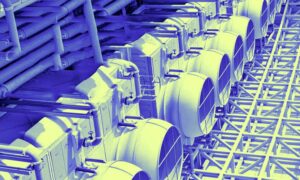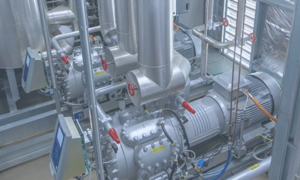Pressing on the need to sustainable cooling in the HVAC&R sector, industry’s air-cooling technology providers discuss the latest technologies to reduce the energy consumption for air cooling and air conditioning.
According to recent study conducted by ‘Research and Markets’, Indian heating, ventilation, and air conditioning (HVAC) mark size is expected to register a 16 percent increase, and reach $31,598 Mn by 2030. This is projected to be the result of increasing investments in commercial, industrial and residential infrastructures in India. This further opens new doors for the industries to innovate newer technologies and enhance the existing capabilities. The realigned growth rate is a result of the expanding investments in commercial, industrial, and residential infrastructure in India, as well as increasing disposable incomes. This provides a platform for the industry to constantly innovate and introduce newer technologies and enhance the capabilities of the existing heating and cooling solutions.
Latest HVAC air cooling technologies
With respect to the latest technologies, there is a global drive for greener options across sectors and markets, including data centers. Noting the same, Ashok Yadav, Product Manager -Thermal, Vertiv India highlights that Vertiv, a global provider of cooling and power infrastructure for data centers of all sizes, is focused on developing new and sustainable innovations with increased energy efficiency and reduced CO2 emissions. Solar HVAC options can be used for both heating and cooling and are therefore very attractive alternatives.
“Due to the increase in remote working caused by the pandemic, businesses are increasingly looking for smart HVAC systems with components and intelligence that allow for monitoring and control of many of the operations without being onsite. Technology is helping enable this from self-regulation to sensors to remote temperature adjustment to integration of energy controls”, explains Yadav.
According to Prasad Mahajan, NSM, HVAC-OEM, CAREL, India, “Efficiency is an important subject of regulations nowadays, and it impacts both the reduction of indirect CO2 emissions and the electricity bill.”
Mahajan further highlights some of the latest technologies like –
- Variable speed compressors (BLDC technology) for improving overall efficiency.
- Use of hybrid technology of refrigerated cooling along with natural evaporative cooling.
- Improving Energy efficiency thru pump automation in chillers, Blower automation (use of VFD or EC fans) for AHU’s.
- Smart technologies like mobile apps that allow building managers to control HVAC technology from one centralised point
- Use of inverter compressor with unique power saving operation with frequency / voltage modulation that saves more energy
- Filtration strategy trend uses antibacterial air filter filtration systems, to protect users from all harmful substances, including odour, bacteria, allergen, virus, micro-dust, etc.
- Installation of ultraviolet light systems in heating and air conditioning systems for improving Indoor Air quality.
Evaluating demand for sustainable cooling
The increase in global warming has increased the need for cooling technologies both on a personal and industrial front. In addition to this, a growing construction sector and increasing per capita income are expected to drive unprecedented demand for cooling technology in India. In a tropical country like India, where sustainability is now at the heart of every innovation, it is important that companies invest in cooling technologies that have minimum impact on their surroundings.
Efficient cooling systems are a key driver of sustainability in data centers. Additionally, it is important to have industry certifications to measure the energy efficiency of data center cooling products and solutions. “Vertiv is investing in Low GWP refrigerant-based product development for long term sustainability and to help with reduction in CO2 emissions. Vertiv also has multiple solutions in DX and CW systems to integrate direct and indirect free cooling solutions which help in maximising efficiency, enhancing reliability, and reducing impact on environment”, Yadav explains.
Cooling Demand in India is already growing at the rate of 15-20 percent annually. With rapid urbanisation and a growing population, there is a demand for sustainable, clean, and energy efficient cooling solutions. According to ICAP 2019, provides a 20-year outlook on the evolving cooling demand, along with several short-term and long-term recommendations to achieve sustainable cooling. Emphasising further on the ICAP, Mahajan says “there must be a transition to use low or no global warming potential (GWP) refrigerants. Also, passively cooled building design and natural ventilation can further reduce cooling load and minimise peak power requirement. We also need to focus more on a sustainable cold chain with adoption of energy efficient technologies like BLDC compressors and drives.”
Energy efficiency of TurboCor chiller technology
Conventional compressors and chillers consume more energy due to the presence of lubricating oil that hinders heat transfer. For instance, a chiller with an oil content of 4% may lose up to 9% efficiency. Many chillers are loaded with excessive oil resulting in energy efficiency rates that are much lower than the equipment’s actual potential. Moreover, An outstanding Integrated Part Load Value (IPLV) is the result of optimum energy performance and saves up to 50 percent of energy through the entire operating range, from 100 percent to ~20 percent.
Continuing the same, Mahajan notes that compressors are the most energy consuming components of refrigeration circuits, thus the use of inverters to increase their performance is being rapidly extended in practice, inverters provide the best way to avoid inefficient on/off cycles that reduce the compressor’s seasonal efficiency This means that, at part load or in low load conditions, an inverter-driven compressor adapts cooling capacity to system requirements without stopping it completely.” As can be seen, ON-OFF cycling is much less efficient up to 75-80 percent of load, as the refrigeration circuit takes time to reach nominal efficiency. Considering that an HVAC/R application works most of the time at part load, energy savings when using DC inverter are quite significant.
Latest cooling / chiller technologies installed
Vertiv recently launched Liebert® VIC, its first liquid cooling solution for high density data centers. The solution, developed in partnership with Green Revolution Cooling, offers improved cooling efficiencies in dense computing environments that increasingly support data-intensive applications such as Internet of Things (IoT), edge computing, and automation.
“The Liebert VIC is a single-phase immersion cooling solution that can support high-density loads of up to 100 kW per rack, utilising warm water. The liquid cooling technology used by Liebert VIC reduces environmental disturbances such as moisture, dust, and poor air quality. In addition, use of warm water cooling enables a highly efficient and low operating cost solution”, says Yadav.
It uses the ElectroSafe™ dielectric liquid coolant, an odorless, non-toxic, single-phase coolant which is both electrically and chemically inert and has 1,200 times the heat capacity of air. This higher heat capacity means that servers with high heat densities can be cooled more effectively, reducing cooling energy costs up to 95 percent.
Whereas, Carel has installed IoT in HVAC/R systems. Key focus of the applications of IoT technologies is site maintenance and continuous optimism. It collects the direct information relating to the connected unit. It also connects the indirect information relating to the users who interact with the connected unit and does a statistical processing of them.
- Carel’s Variable-capacity compressors and drives – Here, an inverter is a drive comprising a complex system of control hardware, power supply and software, designed to adjust the power supplied to a motor from the main power input in order to modulate operating speed.
- Electronic expansion valves – The range of CAREL electronic expansion valves (EXV family) is the widest on the market Using the same technology for the entire range ensures the key features of reliability, performance and cost optimisation
- Evaporative cooling: Pumping and distribution systems for indirect and direct evaporative cooling for air handling units, as well as water spraying systems for finned coil heat exchangers used.
- humiFog, optiMist, KEC and humiSonic are CAREL products that can be used for direct and/or indirect evaporative cooling
Cooling prospects
The growth in the data center cooling market was largely due to enterprises’ growing need for computing capacity, as well as cloud and colocation providers, which are building large data centers. “Cooling solutions like ‘immersion cooling’, in which servers and other IT equipment are submerged in coolant liquid in tanks, and ‘direct-to-chip’, where liquid coolant is fed directly into computer chips in data center equipment to keep them cool, will witness rapid growth in the coming years,” Yadav adds.
“Innovative thinking well ahead of time, while utmost respect towards the environment, is a way of life in Carel. We are continuously bringing out products and solutions for future for past many decades of our existence! This is the reason Carel could maintain its relevance in changing times and committed to do so going into the future”, Mahajan conclude.
Cookie Consent
We use cookies to personalize your experience. By continuing to visit this website you agree to our Terms & Conditions, Privacy Policy and Cookie Policy.















